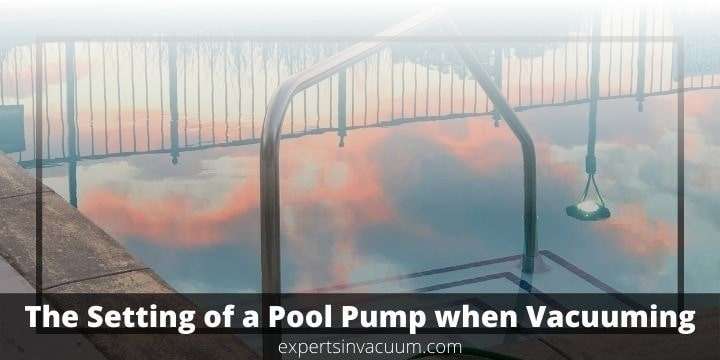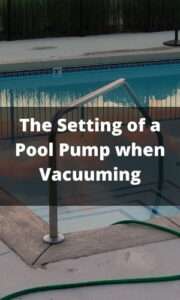A swimming pool pump is a critical device that essentially filters your pool, leaving it safe and clean to swim in. It clears debris from your pool and disperses chemicals used to clean it. However, it is equally important to know what setting the pool pump should be on to vacuum.

The setting that your pool pump should be on to vacuum will depend on whether the pool is in normal condition or heavily contaminated. These two conditions will certainly require different settings of the pool pump.
In this post we will cover:
- What is a Pool Pump and How Does it Work?
- What Setting should my Pool Pump be on to Vacuum?
- Why does my pool pump lose prime when vacuuming?
- Why is my pool vacuum not suctioning?
- Benefits of running my pool pump at lower speeds
- How do I make my pool vacuum suck?
What is a Pool Pump and How Does it Work?
A Pool Pump
A pool pump is an essential operating feature in a swimming pool that allows you to circulate the water in the pool and keep it clean by pumping the water through a filter. The pool is vital in ensuring that the water you swim in is safe and clean.
If you have a pool pump, it will leave your water warm, bacteria-free, and debris-free. Without the pump, your pool water will be ridden with dirt and debris, it will be cold, and have bacteria contamination.
A swimming pool pump has key components that include a water inlet, which is the means by which pool water enters the pump. The maximum flow rate of a pump is dictated by the diameter of the water inlet.
The second is the motor, which is the force behind the pump as it turns the impeller, sucking water into the pump, and then back out of it.
The third is the water outlet, which is the means by which pool water exits the pump. The maximum flow rate is determined by the diameter of the pump.
The fourth is the impeller, which spins to propel water out of the pump. It does this by pulling water into the impeller face and then expelling it out of the pool via its slotted side. The fifth is the filter, which collects debris before it leaves the pool and renter the pool water.
How does it Work?
The most significant tasks of the pump are to circulate water, ensure that there is no water stagnation, and ensure that there is a dispersion of treatment chemicals.
The pool pump carries out these tasks by pulling water through an outlet, funneling it through a filter, and then pumping it back into the pool.
The water enters the pump through a suction line, then the water is filtered to remove impurities. The water then passes through a heat pump, and then it is pumped back into the pool by the pump’s impeller system.
A pool pump uses advanced technology to capture heat in the outside air to heat the swimming pool through its heat pump. The heat is then transferred into the pool, making the water warm and more comfortable.
What Setting should my Pool Pump be on to Vacuum?
Most pool vacuums work in conjunction with the pool’s circulation pump suction to eliminate dirt and debris from the pool’s floor and walls. The hose of the pool vacuum will have to be plugged into the inlet located at the lower part of the skimmer well.
The setup diverts the suction of the pump to the vacuum head. In this case, you will have to roll the vacuum back and forth from above your pool’s bottom. The pool vacuum will suck up all the sediment there.
The sediment will be taken to the pump through the skimmer’s inlet. When pool water is pressurized to run by the pool pump, you can choose to fix the direction of the water.
Therefore, it is essential to determine the desired direction of water flow, by selecting the appropriate setting on the filter valve.
The question, therefore, is what setting the pool pump should be on to vacuum. Generally, there is no need for adjusting your pool pump setting unless it has a speed setting. In this case, you will want to set it to a level that offers you strong suction for your pool vacuum.
Under ordinary conditions of the pool, when you vacuum regularly, the filter valve needs to be kept in the “Filter” state. That will allow the pool vacuum’s dirty water to go through the filter and eliminate all contaminants present in the water.
After the filtration, the clean water is returned to the pool with the backlines. If your pool has moderate and lightweight sediments, it is best to use the “Filter” setting for vacuuming. Once the water returns to the pool, its level will be preserved again.
When the pool is heavily contaminated, the “filter” setting of the pool pump will not work efficiently. If there is a presence of algae at the bottom and on the walls of your pool, the appropriate setting of your multiport valve should be the “waste” or “drain” setting.
The settings will prevent contaminated water from bypassing the filter and instead divert it towards an external drain for disposal. The pool’s filter does not have to deal with the overload of sediment.
After vacuuming with this setting, you will have to refill your pool with water since the water released goes to waste. Adding water will normalize the pool’s water level.
Conclusion
A swimming pool pump is essential for keeping a pool’s water safe and clean. As a result, it is critical to have it in your pool because of the benefits of a clean and safe swimming environment.
However, there are some settings to consider and apply when vacuuming the pool. For example, under normal pool conditions, the pump should be set to “filter,” and when the pool is heavily contaminated, the “waste” or “drain” setting is best.
The “filter” setting is for light pool cleaning, whereas the “drain” or “waste” setting is for heavy cleaning. As a result, before you set the pump, assess the condition of your swimming pool to ensure that you have the proper setting.
FAQs
Why does my pool pump lose prime when vacuuming?
There are several reasons as to why your pool pump may lose prime when vacuuming. The most common reason is the presence of air in the hose.
The solution to this is to hold the vacuum hose up to a return jet while the pump is running when you first put the hose into the water and before putting the vacuum on it. That will blow out the air from the hose.
Secondly, air can also enter the pump through the pump lid O-Ring when the vacuum hose is connected and pressure increases. The pressure can pull in air and cause the pool pump to lose its prime.
The third thing is the holes in the vacuum hose. Any hole near the top and surface will suck in air that will cause the pump to lose prime. The fourth is clogs in the vacuum hose and filter.
The fifth is that when the vacuum hose is attached and suction pressure increases, there will be a collapse of the hose that runs from the pool to the intake of your pump. Ensure that the hose is firm to avoid collapse.
Other reasons include electrical brownouts caused by overheating, lack of water flow, low water levels in the pool, plumbing leaks, and a closed valve that prevents the pump from running.
Why is my pool vacuum not suctioning?
The reasons for suction problems of the pool vacuum include low pool water levels. To remedy this, ensure that the water level in your pool is high enough to cover all skimmers and return jets.
The second is when the pool vacuum hose has a hole in it or it is not fully connected. Ensure that the hose is firmly inserted into the skimmer’s inlet pot and then look for holes and cracks in the hose.
The third is a dirty skimmer filter. In this case, you will have to pull the skimmer basket out and look for any debris interfering with water flow to the pool pump.
The fourth is the entry of air into the pump through the pump cover. In this case, turn the pump on and look for bubbles inside it, which are indicative of air inside the pump. You will have to replace the O-ring cover on the seal.
What are the benefits of running my pool pump at lower speeds?
Running your pool pump at a lower speed has the benefit of saving energy and money. That means that you can run your pump twice as much as you usually do at a higher speed and still save money and energy.
The second is getting cleaner water because a slower cycle will enable the pool pump to distribute chemicals more evenly while trapping unwanted particles that have been added. That will result in your pool water being cleaner.
The third is that reduced speed reduces the noise level of the pump. That is the noise level that is associated with traditional pool pumps.
Fourth, a slower speed cycle enables the water in your pool to be circulated more often by the pool pump, which will make it less susceptible to algae buildup.
The fifth is that the lifespan of your equipment will be prolonged as the slow cycle will reduce the wear and tear of the pump and other pool equipment such as chlorinators, heaters, and filters.
How do I make my pool vacuum suck?
When your vacuum hose has trapped air in it, it will cause your pool vacuum to not suction properly. For you to fix the problem, you can follow these steps:
Cleaning the filter: a clean filter allows more water to pass through, speeds up the vacuuming process and provides you with excellent performance. Therefore, get rid of any dirt and debris from both the skimmer and pump baskets.
Assembling the vacuum: attach the head of the vacuum to the pole of the vacuum and then connect the hose to the head. Check both ends of the hose before connecting.
The one with a swivel cuff needs to be attached to the head. If connected to the skimmer, you will lose suction.
Blowing out the hose: that will get all the air out of the hose, and it should be done by placing the head at the bottom of your pool while still connected to both the hose and pole. Hold the hose over the return jet and the force of water will remove the air in the hose.
Connect the vacuum: hold the hose end that was against the return jet and quickly attach it to the vacuum plate. That should be done quickly to prevent air from getting into the hose.
